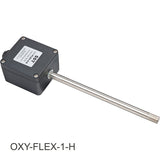
Oxygen sensors can be generally broken into 2 groups: oxygen sensors use to measure or monitor biological processes, and industrial oxygen sensors.
- Oxygen sensors for biological processes are used to monitor oxygen levels in the 17-25% range, the volume of oxygen in air needed to support human or biological life. These sensors range from medical oxygen sensors that monitor blood oxygen levels to oxygen depletion safety alarms that test for low oxygen levels in enclosed areas.
- Industrial oxygen sensors are used to measure anything from 0 parts per billion oxygen molecules by volume up to 100% pure oxygen. They are designed to not only monitor oxygen levels, but to provide a feedback mechanism to control the level of oxygen in industrial processes.
Industrial Oxygen Sensor Applications
Industrial oxygen sensors are most commonly used for:
Monitoring Combustion
For example, the most common industrial oxygen sensors are the ones in modern cars. Oxygen sensors monitor the amount of oxygen in exhaust gases and report back to the car’s computer. The sensors let the computer know if the air-fuel mixture is rich (not enough oxygen) or lean (too much oxygen). The computer uses this information to adjust the fuel mixture accordingly, then waits for the oxygen sensor to report the success or failure of the change. This feedback loop results in constant updates, maximizes fuel economy and minimizes exhaust fumes.
Just like cars, furnaces and power plants use flue gas oxygen sensors to monitor oxygen levels in smokestacks. Once the oxygen level in the exhaust gas is known, the fuel level can be increased or decreased to maximize burning. Like automobiles, this is important because combustion without enough oxygen leads to the production of carbon monoxide, a dangerous gas.
The other difference between oxygen sensors for industrial processes is that they may be used to measure anything between zero and 100% oxygen. Both are “man-made” oxygen levels not found in nature.
Measuring Trace Oxygen
For example, a trace oxygen sensor is designed to measure oxygen levels at the parts per million or parts per billion level. Trace oxygen sensors are used when even a small number of oxygen molecules are not desired in an industrial process.
For example, trace oxygen sensors are to verify argon purging during the welding of stainless steel. Stainless steel and some other metals are sensitive to the presence of oxygen during TIG welding.
The oxygen chemically combines with the hot metal as it is being joined and weakens the bond. Purging solves this problem by displacing the oxygen with argon, then using a weld purge monitor to verify there are no trace levels of oxygen before welding begins.
Another example where trace oxygen levels measured is Modified Atmosphere Packaging.

Modified atmosphere packaging (MAP) is the process of removing all or most of the oxygen from inside the packaging of foods, drinks, makeup and pharmaceuticals to increase shelf-life. For example, a desktop or handheld MAP oxygen analyzer is used to verify trace oxygen levels in the packaging gas testing for QC or as a headspace oxygen analyzer for spot testing.
Like MAP, trace oxygen sensors are used in controlled atmosphere storage (CAS) to verify the oxygen levels in bulk food storage containers or grain silos. Low oxygen levels can be used to extend the life of stored bulk foods.
Measuring 100% Oxygen
Industrial oxygen sensors capable of measuring 100% oxygen are important for verifying the purity of liquid oxygen in pressurized tanks and cylinders.
Pure oxygen is used for:
- Medical including hyperbaric therapy
- SCUBA, underwater, safety, or aviation breathing gas
- Smelting, cutting and welding metals
- Oxyacetylene welding
- Liquid propellant for rocket engines
The term “pure oxygen” means different things in different industries. The Compression Gas Association grades oxygen A-G according to its purity. Oxygen may also certified by the United States Pharmacopeia (USP) as certified for welding, research, aviation or medical. Depending on the grade pure oxygen can be anywhere from 99.95% to 99.999% (5-nines).
In the laboratory, pure oxygen may be used as a bleaching or oxidizing agent. During silicone device manufacturing, oxidation of the wafer surface is part of the sequence of steps required to create an integrated circuit. Pure oxygen is a component in the creation of span and calibration gas used to test other sensors.

To create pure oxygen 100% oxygen sensors are used to verify gas as it is produced. The oxygen may be produced by portable medical oxygen concentrators that pull oxygen from the surrounding air, or by an industrial PSA oxygen generator. In both cases, 100% oxygen sensors like this one from SST can be used to verify the oxygen purity.
References:
https://www.oxygenconcentratorstore.com/blog/what-is-medical-grade-oxygen-and-why-do-i-need-an-rx/
https://en.wikipedia.org/wiki/Oxygen_storage

